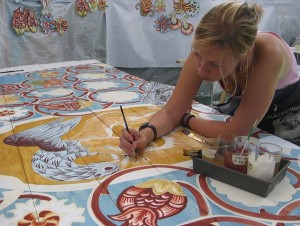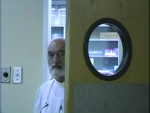In The Singing Abortionist, Dr. Henry Morgentaler comes across as an enigmatic figure. (photo from Vancouver Jewish Film Festival)
This year’s Vancouver Jewish Film Festival will entertain, inform and challenge viewers, from its opening event – YidLife Crisis, a film all in Yiddish (with English subtitles), and its Yiddish-speaking stars/writers Jamie Elman and Eli Batalion as guests – to its final screening, the French film Once in a Lifetime, based on the true story of an inner-city high school in Paris. This week, the Jewish Independent gives you a glimpse into the festival, which runs Nov. 5-12 at Fifth Avenue Cinemas.
A difficult national hero
There are few surnames in Canada that can evoke such visceral and opposite reactions as Morgentaler. Henry Morgentaler is the name most associated with abortion – with providing abortion services to women, with fighting abortion laws, and for eventually leading a case to the Supreme Court of Canada that resulted in the permanent overturning of Canada’s abortion statute.
To allies, he is a hero. To enemies, he is “Hitler,” as countless people scream at him in footage in the documentary The Singing Abortionist. (He was known to hum or sing a few lines while performing abortions, including one he performed on CTV’s W5 program, which ran the procedure in its five-minute entirety.) Yet even to allies – including his children – he is, as one biographer described him, a “difficult hero.”
In interviews before his death in 2013, Morgentaler acknowledged that everything he did in life was with the aim of earning the love of women. This guided him in becoming the foremost advocate in the country for women’s reproductive choice, but it also led to his reputation as a “womanizer.”
Morgentaler was a relatively unknown doctor when he felt morally bound to begin offering abortions, a crime that carried a potential life sentence for the doctor and two years in prison for the patient. Across 20 years of legal battles, including a stint in prison, Morgentaler led the legal and PR battle for choice, which culminated in his case before the Supreme Court of Canada that, in 1985, struck down Canada’s abortion law.
In this one-hour film, Morgentaler comes across as an enigmatic figure. He admits to megalomania, albeit with a guffaw. His children speak about their own conflicted relationships with him. His lawyer says Morgentaler was an easy target for anti-abortion forces to caricature as a “strange-looking, hook-nosed Jew.” Morgentaler is both introspective about his motivations but clearly suppresses, according to those around him, his experiences as a Holocaust survivor.
But Morgentaler’s career – particularly his lifelong devotion to the fight for abortion rights – is a direct result of his suffering under Nazism. He was a forced laborer in the Lodz Ghetto before it was liquidated and its residents sent to Auschwitz. The film follows Morgentaler on his only return to the place where he lost his mother, and where he and his brother survived. The experience, he tells the filmmaker, taught him that, “Just the fact that something is law does not necessarily mean it is good or justified or it’s rational.”
– PJ
Monumental reconstruction
Before the Holocaust, Poland had about 200 wooden synagogues, a richness of liturgical architecture that one expert said “rivals the greatest wooden architecture anytime in history, anywhere in the world.” All were lost.
That American expert, Rick Brown, began a project to painstakingly reconstruct from photographic and other records a prime example of that lost history. Working, first, with his students at the Massachusetts College of Art, the project eventually expanded to include more than 300 people, mostly students, from 46 universities and 11 countries.

The undertaking was monumental. Using only the tools that were available at the time, and working on site over successive summers in Poland and Ukraine, the team recreated the intricately constructed and painted roof and ceiling of Gwozdziec Synagogue. (Gwozdziec is actually in Ukraine, but was part of the greater Polish territory during the heyday of synagogue architecture and its synagogue is both one of the most dramatic and one with the most information available to aid the team in recreating it.)
Brown and his group didn’t know what they would do with the to-scale project when it was completed, but fate intervened. The POLIN Museum of the History of Polish Jews had been designed to accommodate exactly such a replica. After years of tree-felling, lathing, metalworking, complex joinery and scrupulous research on building techniques and paint colors, the roof and ceiling were raised into place at the Warsaw museum.
Raising the Roof, the film that tells the story of the project, is fascinating on multiple fronts. It involves many people with divergent motivations, including Jews, non-Jews, Americans, Poles, artists and even volunteers with no particular skill beyond enthusiasm. There are poignant reflections on the meaning of the original architecture, its loss and regeneration. Underpinning the entire project is the memory of the lost civilization of Polish Jewry, from which 70% of today’s Jews have ancestry, and whose architecture and culture can be reclaimed, but whose existence cannot.
– PJ
Being high and low in Haifa
If you can hand yourself over to filmmaker Elad Keidan and immerse yourself in the sights of Yaron Scharf and especially the sounds created by Aviv Aldema, Afterthought is a worthwhile journey.

The Israeli film’s Hebrew title, Hayored Lema’ala, “down up,” basically sums up what happens on the outward level. Moshe, whose name and story we don’t find out till almost the very end, goes off in search of his wife’s lost earring, which leads to other discoveries about his wife and their relationship. As he starts his exploration up the stairs to the top of Mount Carmel in Haifa, Uri begins his descent to the port, where, we eventually find out, he is planning on catching a freighter abroad, both to finish writing a book and to avoid army reserve duty, as well as to run away from mistakes he has made. The two men pass the same sights, sounds and people at different points in the day, and they encounter each other, stopping for a brief chat – Moshe was Uri’s third-grade teacher, it turns out.
The English title for the film comes from a conversation Moshe overhears in a coffee shop. A man tells his friend about how he wishes that, after a talk with his mother, for example, he could call his mom and leave a message with everything that he actually wanted to say, or meant to say.
Afterthought is Keidan’s first feature, and it is a solid debut despite the slow pace. Viewers are ultimately rewarded by the internal ups and downs of the main characters, the men’s reflections on life, friends and family, and the people they meet along the way. Aldema’s radio snippets, machine and human noises, music selections and other sound effects are a character in and of themselves, and are worth the price of admission alone. These, together with Scharf’s cinematography – which is not flashy, but subtly effective – and the acting of Itay Tiran as Uri and Uri Klauzner as Moshe make for a movie that will not only have you thinking of it afterwards, but of your own life, the choices you have made, and the people you hold dear.
– CR
For the film schedule, tickets and information on all the festival’s offerings, visit vjff.org.

